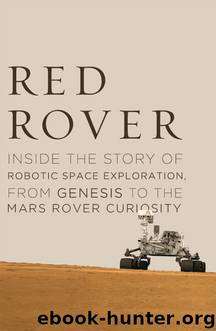Red Rover by Roger Wiens

Author:Roger Wiens [Wiens, Roger]
Language: eng
Format: epub
ISBN: 9780465055982
Publisher: Basic Books
Published: 2015-01-12T16:00:00+00:00
chapter
fourteen
CANCELED
THE MSL ROVER PROJECT GOT ALONG FINE FINANCIALLY FOR the first two years. Some areas grew in cost, but the program had more than enough in reserve to cover these areas. I thought the rover was doing very well for a major project of its size. Most of the large missions I had known ended up in financial trouble immediately. NASA’s usual response was to remove instruments from the payload. These removals, or descopes, could sometimes cripple the mission’s scientific return while yielding only a very small cost savings. But there are only two other options when cost runovers occur: letting the costs rise, or canceling a mission altogether. The problem is that the really big costs on every mission are the launch vehicle (the rocket), the software, and a lot of the engineering needed to make it all work. In short, the bulk of the costs are for essentials.
In the case of the MSL rover, the payload had started at $75 million out of what was then a $1.4 billion mission. If the total mission costs increased by just 7 percent, or $100 million, NASA could conceivably wipe out the whole payload—the whole reason for the mission—and still not save enough money to contain the mission to the original cost.
The $75 million figure for the payload had been inadequate from the beginning. Although all of the instruments had originally added up to $75 million, many things had to be changed on each one to meet the actual specifications of the rover. In the case of ChemCam, the wiring between the mast and the body was to be supplied by JPL. We were going to use voltage converters in the body to power the mast. However, the wires specified by JPL were so thin that the voltage would drop significantly going from the body to the mast, so we had to change our plans. Then there was the issue of the optical fibers, which was taking a lot of our resources.
On top of that, JPL was getting worried about the mass of the rover. Every subsystem seemed to be gaining weight. To hold the line, JPL announced to the payload leaders that it would pay for us to find ways to lighten our instruments. We had planned to make our spectrometers out of titanium, which was very stable thermally, to accommodate our optics. John Bernardin, our systems engineer, suggested that we build these units out of beryllium.
Beryllium is very expensive to manufacture and requires special controls because beryllium dust is a health hazard. Using beryllium for ChemCam would mean a longer time at the manufacturer, special training for team members, and a lot of restrictions on what we could do to modify the units. All of that costs money, but it would save about 2 pounds, almost cutting the weight of our body-mounted unit in half, and JPL was willing to pay several hundred thousand dollars for that. We agreed to lighten ChemCam in exchange for the increase in funding.
The various changes to our instrument added up to a couple of million dollars.
Download
This site does not store any files on its server. We only index and link to content provided by other sites. Please contact the content providers to delete copyright contents if any and email us, we'll remove relevant links or contents immediately.
| Aerodynamics | Aircraft Design & Construction |
| Astronautics & Space Flight | Avionics |
| Gas Dynamics | Propulsion Technology |
Whiskies Galore by Ian Buxton(41864)
Introduction to Aircraft Design (Cambridge Aerospace Series) by John P. Fielding(33064)
Small Unmanned Fixed-wing Aircraft Design by Andrew J. Keane Andras Sobester James P. Scanlan & András Sóbester & James P. Scanlan(32743)
Craft Beer for the Homebrewer by Michael Agnew(18140)
Turbulence by E. J. Noyes(7934)
The Complete Stick Figure Physics Tutorials by Allen Sarah(7307)
Kaplan MCAT General Chemistry Review by Kaplan(6865)
The Thirst by Nesbo Jo(6825)
Bad Blood by John Carreyrou(6542)
Modelling of Convective Heat and Mass Transfer in Rotating Flows by Igor V. Shevchuk(6391)
Learning SQL by Alan Beaulieu(6208)
Weapons of Math Destruction by Cathy O'Neil(6139)
Man-made Catastrophes and Risk Information Concealment by Dmitry Chernov & Didier Sornette(5920)
Digital Minimalism by Cal Newport;(5661)
Life 3.0: Being Human in the Age of Artificial Intelligence by Tegmark Max(5472)
iGen by Jean M. Twenge(5365)
Secrets of Antigravity Propulsion: Tesla, UFOs, and Classified Aerospace Technology by Ph.D. Paul A. Laviolette(5309)
Design of Trajectory Optimization Approach for Space Maneuver Vehicle Skip Entry Problems by Runqi Chai & Al Savvaris & Antonios Tsourdos & Senchun Chai(5011)
Electronic Devices & Circuits by Jacob Millman & Christos C. Halkias(4906)
